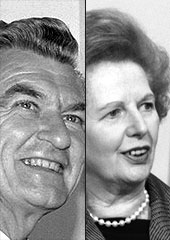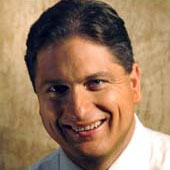Thatcher Vs. Hawke: Whose Reforms Worked Best?
Who left behind a stronger economy: the warrior-like conservative British Prime Minister or Australia’s bridge-builder?
April 19, 2013

In 1983, four years into Margaret Thatcher’s lengthy Conservative premiership in Britain, Australia took the opposite tack, voting in Labor Prime Minister Bob Hawke, who was re-elected three times thereafter. In terms of an economic legacy, did Thatcherism work? Or did Bob Hawke’s strategy to “Bring Australia together” through consensus rather than conflict achieve better outcomes?
To answer this question, I consulted my University of New South Wales colleague Raja Junankar, who worked and lived in both the UK and Australia under Thatcher and Hawke. He looked at gross domestic product and industrial production, employment and unemployment, inflation and international trade through both the Thatcher and Hawke eras.
In terms of GDP, Australia outperformed Britain in 12 of the 18 years after Thatcher came to power. And despite Thatcher’s monetarist philosophy of “fighting inflation first,” Australia had a lower inflation rate than Britain for nine of those 18 years.
In terms of international trade, Australia had a positive trade balance for ten of the 18 years, while Britain’s worsened over 1983-88 and then improved, partially thanks to the proceeds from its North Sea oil fields.
In terms of the labor market, Thatcher and Hawke had very different approaches. Thatcher “deregulated” the labor market, abolished the minimum wage, encouraged industrial confrontation (notably with the miners’ union) and encouraged “the right of managers to manage.”
By contrast, Hawke adopted a “consensus” model in the Accord with the Australian Council of Trade Unions (of which he was the former president), introduced a “social wage” (providing Medicare, Superannuation, education and training, labor market adjustment and tax cuts) in exchange for industrial peace and nominal wage restraint with an inflation target.
Hawke also initiated a National Economic Summit of business, farmers, unions and community groups at the start of his term, something Thatcher never would have contemplated as a so-called “conviction” politician.
In terms of the labor market, Australia’s employment growth exceeded Britain’s in all but three of the years covered. In terms of unemployment, the Thatcher government made 17 changes to the official measurement of unemployment (all of which lowered the unemployment rate). Even so, Australia achieved a lower unemployment rate in the 1980s, Britain in the 1990s, until a reversal saw Australia again outperform Britain.
Over the whole period, if the difference between the unemployment rates of Britain and Australia are accumulated, the UK unemployment rate was 6.5 percentage points higher than Australia, with a higher proportion of long-term unemployed people in the UK than Australia for every year of comparison. On the labor market, Australia clearly outperformed Britain.
Finally, there is the economic legacy now. It has been over 23 years since Margaret Thatcher left Downing Street and 22 years since Bob Hawke was prime minister. In 2013, the economic positions of Australia and Britain are in stark contrast.
Hawke’s bet on opening the Australian economy to Asia, and converting the famous “tyranny of distance” to the “power of proximity” has paid off. Australia has been transformed from the double-digit inflation and unemployment of 1983 to the best-performing economy in the OECD. It has avoided any recession in 22 years, despite several global external shocks.
By contrast, Britain has an unemployment rate of 7.9%, with 2.62 million people unemployed (compared to Australia’s current 5.6% unemployment and almost 686,900 unemployed). The UK economy is overreliant on industries like financial services that were hit in the global financial crisis.
As Australia’s economy grows, Britain’s contracts, and the UK has an inflation rate above its central bank range, unlike Australia. Australia shades Britain in terms of GDP per capita as well.
In conclusion, to be fair to Margaret Thatcher, she did show remarkable courage on noneconomic issues, such as staring down the Irish Republican Army terrorists who tried to assassinate her or standing up to the Soviet Union (particularly when they were oppressing Solidarity trade unionists in Poland). She did, however, have a blind spot with regard to South Africa’s apartheid regime and race issues.
But when it comes to Thatcher’s economic legacy, when compared to Australia’s experience at around the same time, you’d have to say that the evidence clearly shows that in economic policy, Bob Hawke’s reforms for Australia came out ahead.
Takeaways
To be fair to Thatcher, she did show remarkable courage on noneconomic issues, such as staring down Irish Republican Army terrorists and standing up to the Soviet Union.
Hawke's bet on converting the famous "tyranny of distance" to the "power of proximity" has paid off.
Hawke adopted a "consensus" model: achieving accord with labor unions and introducing a "social wage."
Thatcher "deregulated" the labor market, abolished the minimum wage, and encouraged industrial confrontation.
Australia's economic growth outperformed Britain in 12 of 18 years after Thatcher came to power.
Read previous
Funny Money and the Super-Rich
April 18, 2013
